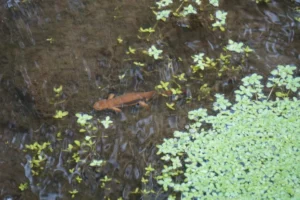Salamanders live in damp environments with clean water. They crawl under leaves, logs, and stones, often hidden from view, but they are very important for keeping these areas healthy. You might wonder: are these quiet, secretive creatures protected by law?
Yes, many salamanders are protected, but how much protection they have depends on the species and where they live. Some salamanders are fully protected from being caught, sold, or harmed. Others have only partial protection
Why Salamanders Need Protection
Salamanders are very sensitive animals. Their skin is very thin, so chemicals, dirt, and sudden changes in the environment can easily hurt them.
They eat insects, spiders, and worms, keeping insect numbers under control. Birds, snakes, and fish rely on salamanders for food.

Losing salamanders can change the balance in these environments.
Many salamanders live in only a few special areas. If these areas are damaged, the species could disappear. Protecting salamanders also protects many other animals and plants.
What Threats Do Salamanders Face?
Even when their surroundings look safe, salamanders face many dangers. Logging, farming, road building, and expanding towns can destroy or break up the places they live.
Pollution in streams from chemicals, pesticides, and waste can harm their delicate skin or poison the insects they eat.
Changes in temperature and rainfall from climate shifts can dry up breeding ponds and lower survival rates. Disease, like fungal or viral infections, can spread quickly and kill many salamanders.
Because salamanders are so sensitive, legal protection and keeping their environments safe are very important to keeping populations healthy.
Which Salamanders Are Protected?
Protection depends on the species and the region.
Endangered salamanders, like the California tiger salamander in the United States or the Chinese giant salamander in Asia, get strong legal protection. They can’t be collected, harmed, or sold.

Other species are protected only in certain areas or during breeding seasons. Common species might not have full legal protection, but conserving the areas they live in still helps their populations stay healthy.
Knowing which salamanders are protected lets you follow the rules and support conservation efforts correctly.
How Laws Protect Salamanders
Laws work in many ways to protect salamanders:
- Some make it illegal to catch, sell, or hurt certain species.
- Others protect forests, streams, and wetlands where salamanders live.
- Trade rules stop rare salamanders from being sold in other countries.
- Breeding programs help endangered salamanders grow in number.
National laws protect rare species. Local laws protect the environments they live in. Together, these laws give salamanders a chance to survive and reproduce safely.
How Countries Protect Salamanders
Different countries protect salamanders in different ways.
- United States: The Endangered Species Act protects species like the Shenandoah salamander and the California tiger salamander. States add extra rules, like forbidding collection or harming their environments.
- Canada: Some salamanders are listed under the Species at Risk Act. Provinces also make local rules to protect their environments.
- Europe: The EU Habitats Directive protects many salamanders. Disturbing their environments or trading them illegally is against the law.
- Asia and Latin America: Some countries protect native salamanders, but enforcement can be weak. International trade of endangered species is limited under CITES.
Even with strong laws, enforcement is important. Wildlife officers, rangers, and conservation groups monitor salamander populations and investigate illegal activity to make sure the rules work.
How Protecting Environments Helps Salamanders
Legal protection alone is not enough. Salamanders need safe, healthy environments to live and breed. Forests, streams, wetlands, and underground burrows give them food, shelter, and breeding sites.
Protected areas like national parks, wildlife reserves, and wetlands give salamanders a chance to survive with minimal human disturbance.

Conservation groups restore damaged environments by cleaning streams, planting native plants, and creating small ponds for breeding.
Even small changes, like roads or buildings, can block salamanders from moving freely. Laws that protect environments make sure they have safe places to live and grow.
What About Salamanders in the Pet Trade?
Some salamanders are popular pets because of their colors or rarity. This makes them vulnerable.
- Many species can’t be taken from the wild without a permit.
- Selling or exporting protected salamanders without permission is illegal.
- Captive-bred salamanders are the best legal option for pet owners.
Even if a species is not endangered, taking animals from the wild can hurt local populations and spread disease. Following trade laws helps salamanders survive in their natural environments.
Are International Laws Helping Salamanders?
Global organizations track salamanders and the risks they face. The IUCN Red List classifies species as vulnerable, endangered, or critically endangered.

The Red List guides governments and conservationists on which species need urgent action, even though it doesn’t make laws.
CITES regulates the trade of endangered salamanders across borders to prevent illegal sales.
International efforts work with national and local laws to protect populations and keep their environments healthy.
How You Can Protect Salamanders
You don’t need to be a scientist or ranger to make a difference. Small actions can help.
- Avoid polluting streams, ponds, and wetlands.
- Reduce pesticide use near damp areas.
- Support groups restoring forests and wetlands.
- Observe salamanders responsibly , don’t take them from the wild.
- Learn about local salamander species and report sightings to conservation groups.
When you take these steps, you help keep salamanders alive and protect the animals and plants that depend on them.
Are Conservation Efforts Working?
Some species have bounced back thanks to laws and habitat restoration.
- The California tiger salamander has grown in protected breeding ponds in the U.S.
- The great crested newt in Europe increased in areas with restored ponds and stricter collection laws.
- Captive breeding programs for the Chinese giant salamander are reintroducing healthy populations to rivers and streams.
These examples show that when laws, environments, and people work together, salamanders can survive and even thrive.
Conclusion
Salamanders are protected in many parts of the world, but protection varies by species and location. Laws, habitat conservation, trade restrictions, and public awareness all work together to keep these quiet, secretive creatures safe.
Protecting salamanders is not just about saving one animal. It keeps water clean, forests healthy, and ecosystems balanced.
When you follow the rules, support conservation efforts, and learn about these animals, you can help salamanders survive and thrive for generations.
Hi, my name is Ezra Mushala, i have been interested animals all my life. I am the main author and editor here at snakeinformer.com.

